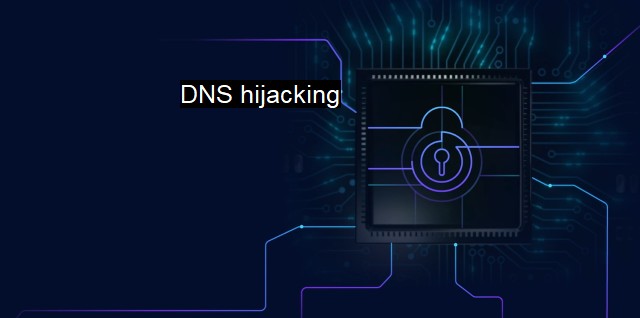What is DNS hijacking?
The Ins and Outs of DNS Hijacking and Its Role in Cybersecurity: An In-Depth Look at Antivirus Programs
DNS hijacking is a prevalent malicious activity primarily involved with subverting the resolution process of system domain names. DNS, the Domain Name System, is an Internet service that translates domain names into IP addresses. Its goal is to make browsing the web easier for users by taking numerical IP locations and converting them into easily remembered names. because this service is so vital to our online experiences, it presents a prime target for hackers, leading to the emergence of DNS Hijacking.DNS hijacking, often termed as DNS redirection, is a process where hackers intercept DNS queries from their intended track and divert those queries towards a rogue DNS server. This practice destines Internet users to alternate websites (typically malevolent cyber-doorways masquerading as genuine sites) determined by the rogue DNS server. In this state, users unknowingly interact with these fabricated web presences that can ensnare personal-identification data, financial details, and other sensitive information.
DNS hijacking thrives in the shadows. Most users don't realize they've become victims until it's too late. This results from the unobtrusive nature of this hacking method. Perpetrators manipulate the behavior of lonely DNS servers, seldomly affecting the operating efficiency of the system, which would possibly alert users.
There are two prevalent methods of DNS hijacking used by cybercriminals. The first is through the use of scrubbed Trojan threats on a local computer or an organization’s devices. If the spyware can successfully infiltrate the host computer’s gateway, it reroutes the server access to a custom DNS server. Then, the Trojan subtly alters IP address settings to correspond to their rogue DNS server, effectively transforming the target's web traffic to their web-page replicas.
The second approach involves ISP DNS hijacking, in which your Internet Service Provider redirects a user's browser requests. The ISP can do this remotely and without your permission, often to serve you additional advertisements or to stop you from visiting particular websites. Because your internet activity passes through your ISP, they can intercept any of your requests and redirect you as they see fit.
Antivirus solutions are critical in preventing DNS hijacking. An efficient antivirus solution safeguards users from scrubbed Trojan attacks, verifying all changes made to the IP settings, thus blocking any irregular modulations to the system settings. As far as ISP DNS hijacking goes, employing cyber-security practices like DNSSEC (DNS Security Extensions) will ensure the authenticity of the DNS responses. DNSSEC introduces a degree of assurance, using digital signatures based on public key cryptography to authenticate the validity of data.
Another preventive measure involves routine device and network safety check-ups, verifying the centerpiece IP and DNS settings have remained unaltered. Especially for organizations, incorporating Intrusion Prevention Regularity and network firewall mechanisms can significantly minimize the vulnerability of devices to such infiltration. Utilizing encrypted networks is another security measure, ensuring that the user's communication cannot be intercepted by unauthorized parties.
Maintaining automation in updating user devices with the latest system/antivirus updates greatly contributes to staying shielded against such threats. Active vigilance ensures that all newly identified vulnerabilities in the system software, that could be potentially exploited by hackers, get swiftly patched up.
To sum up, DNS hijacking is a surreptitious practice adept in exploiting an Internet foundational service – the DNS, and garners malware programmers' attention due to its subtlety and plain sailing exploitation. Therefore, adopting the efficient antivirus and cybersecurity solutions is paramount. The war against cybercrime is more arduous than ever, and one ounce of prevention is worth more than a pound of cure when it involves personal data and sensitive information.

DNS hijacking FAQs
What is DNS hijacking?
DNS hijacking, also known as DNS redirection or DNS poisoning, is a type of cyber attack in which an attacker intercepts and redirects DNS requests to a malicious website. This allows the attacker to steal sensitive information or launch other types of attacks.How does DNS hijacking work?
DNS hijacking works by changing the DNS settings on a victim's computer or router. When the victim types in a website's URL, their DNS request is intercepted and redirected to a fake website controlled by the attacker. The victim is then tricked into entering sensitive information, such as login credentials or credit card numbers, on the fake website.What are the dangers of DNS hijacking?
DNS hijacking can be very dangerous because it allows attackers to intercept sensitive information and control a victim's internet traffic. This can lead to identity theft, financial loss, and other types of attacks. Additionally, DNS hijacking can make it difficult for victims to access legitimate websites, which can be very disruptive to their daily lives.How can I prevent DNS hijacking?
There are several steps you can take to prevent DNS hijacking. These include using a reputable antivirus or anti-malware program, keeping your operating system and software up to date with the latest security patches, using a secure DNS service, and being cautious when clicking on links or downloading attachments from unknown sources. It's also a good idea to regularly check your DNS settings to make sure they haven't been changed without your knowledge.| | A | | | B | | | C | | | D | | | E | | | F | | | G | | | H | | | I | | | J | | | K | | | L | | | M | |
| | N | | | O | | | P | | | Q | | | R | | | S | | | T | | | U | | | V | | | W | | | X | | | Y | | | Z | |
| | 1 | | | 2 | | | 3 | | | 4 | | | 7 | | | 8 | | |||||||